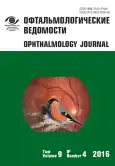Superior orbital fissure syndrome caused by an internal carotid artery aneurysm in the cavernous sinus
- 作者: Astakhov Y.S.1, Marchenko O.A.2, Potemkin V.V.1, Titarenko A.I.1
-
隶属关系:
- FSBEI HE I.P. Pavlov SPbSMU MOH Russia, Saint Petersburg
- Ophthalmologic Center of City hospital No 2
- 期: 卷 9, 编号 4 (2016)
- 页面: 102-106
- 栏目: Articles
- URL: https://journals.rcsi.science/ov/article/view/6015
- DOI: https://doi.org/10.17816/OV94102-106
- ID: 6015
如何引用文章
详细
This article describes a case of superior orbital fissure syndrome caused by an internal carotid artery aneurysm in the cavernous sinus. Etiology, clinical presentations, and diagnostic methods are discussed. Possible regression of signs and symptoms after timely endovascular treatment of an internal carotid artery aneurysm in the cavernous sinus is reported.
作者简介
Yuriy Astakhov
FSBEI HE I.P. Pavlov SPbSMU MOH Russia, Saint Petersburg
编辑信件的主要联系方式.
Email: astakhov73@mail.ru
MD, doctor of medical science, professor. Department of Ophthalmology
俄罗斯联邦Ol’ga Marchenko
Ophthalmologic Center of City hospital No 2
Email: oamarchenko@yandex.ru
ophthalmologist
俄罗斯联邦Vitaly Potemkin
FSBEI HE I.P. Pavlov SPbSMU MOH Russia, Saint Petersburg
Email: potem@inbox.ru
PhD, assistant professor. Department of Ophthalmology
俄罗斯联邦Aleksandra Titarenko
FSBEI HE I.P. Pavlov SPbSMU MOH Russia, Saint Petersburg
Email: titarenko@yandex.ru
resident. Department of Ophthalmology
俄罗斯联邦参考
- Пономарев В.В., Барановский А.Е., Сытый Ю.В., Живолупов С.А. Каротидные артериальные аневризмы, симулирующие синдром Толоса — Ханта // Неврологический журнал. – 2014. – Т. 19. – № 5. – С. 13–21. [Ponomarev VV, Baranovskiy AE, Sytiy YuV, Zhivolupov SA. Carotid arteries aneurysms masquerade as Tolosa-Hunt syndrome. The Neurological Journal. 2014;19(5):13-21. (In Russ.)]
- Bars HW, Blackwood W, Meadows SP. Intracavernous carotid aneurysms. A clinical-pathological report. Brain. 1971;94:607-22. doi: 10.1093/brain/94.4.607.
- Bavinzski G, Killer M, Ferraz-Leite H. Endovascular therapy of idiophatic cavernous aneurysms over 11 years. Am J Neuroradiol. 1998;19:559-65.
- Drazin D, Choulakian A, Nuno M, et al. Improvement in Visual Symptomatology after Endovascular Treatment of Cavernous Carotid Aneurysms. J of Vascular and Interventional Neurology. 2013;6:15-21.
- de Vasoncellos LP, Flores JA, Veiga JC, et al. Presentation and treatment of carotid cavernous aneurysms. Arq Neuropsiquaitr. 2008;66:189-193. doi: 10.1590/S0004-282X2008000200009.
- Eddleman CS, Hurley MC, Bendok BR, et al. Cavernous carotid aneurysms: to treat or not to treat? Neurosurg Focus. 2009;26(5): E4. doi: 10.3171/2009.2.FOCUS0920.
- Evans HH, Wurth BA, Penna KJ. Superior Orbital Fissure Syndrome: A Case Report. Craniomaxillofac Trauma Reconstruction. 2012;5:115-120. doi: 10.1055/s-0032-1313363.
- Goldenberg-Cohen N, Curry C, Miller NR, et al. Long term visual and neurological prognosis in patients with treated and untreated cavernous sinus aneurysms. J Neurol Neurosurg Psychiatry. 2004;75:863-867. doi: 10.1136/jnnp.2003.020917.
- Hahn CD, Nicolle DA, Lownie SP, et al. Giant Cavernous Carotid Aneurysms: Clinical Presentation in Fifty-seven Cases. Journal of Neuro-Ophthalmology. 2000;20(4):253-258. doi: 10.1097/00041327-200020040-00010.
- Kai Y, Hamada J, Morioka M, et al. Treatment strategy for giant aneurysms in the cavernous portion of the internal carotid artery. Surgical Neurology. 2007;67:148-155. doi: 10.1016/j.surneu.2006.03.037.
- Lakke JP. Superior orbital fissure syndrome: Report of a case caused by local pachymeningitis. Arch Neurol. 1962;7:289-300. doi: 10.1001/archneur.1962.04210040041004.
- Lenzi GL, Fieschi C. Superior Orbital Fissure Syndrome. Eur Neurol. 1977;16(1-6):23-30. doi: 10.1159/000114876.
- Linskey ME, Sekhar LN, Hirsch WL, et al. Aneurysms of the Intracavernous carotid artery: natural history and indications for treatment. Neurosurgery. 1990;26:933-938. doi: 10.1227/00006123-199006000-00002.
- Menon, et al. EC-IC bypass for cavernous carotid aneurysm. Asian Journal of Neurosurgery. 2014;9(2):84-85. doi: 10.4103/1793-5482.136718.
- Morris P, ed. Practical Neuroangiography. 3rd ed. Lippincott Willis & Wilkins; 2013. P. 279-84.
- Postma MP, Seldomridge GW, Vines FS. Superior Orbital Fissure Syndrome and Bilateral Internal Carotid Pseudoaneurysms. J Oral Maxillofac Surg. 1990;48:503-508. doi: 10.1016/0278-2391(90)90241-S.
- Rai S, Rattan V. Traumatic superior orbital fissure syndrome: Review of literature and report of three cases. National Journal of Maxillofacial Surgery. 2012;3(2):222-225. doi: 10.4103/0975-5950.111392.
- Reymond J, Kwiatkowski J, Wysocki J. Clinical anatomy of the superior orbital fissure and the orbital apex. J Craniomaxxilofac Surg. 2008;36:346-53. doi: 10.1016/j.jcms.2008. 02.004.
- Rohrich RJ, Hackney FL, Parikh RS. Superior orbital fissure syndrome: current management concepts. J Craniomaxxilofac Trauma. 1995;1(2):44-48.
- Rosi JJ, Willing LC, Yeng LT, et al. Cavernous carotid artery aneurysms: Epidemiology, natural history, diagnostic and treatment. An experience of a single institution. Clinical Neurology and Neurosurgery. 2014;125:32-35. doi: 10.1016/j.clineuro.2014.07.015.
- Stiebel-Kalish H, Kalish Y, Bar-On RH, et al. Presentation, Natural History, and Management of Carotid Cavernous Aneurysms. Neurosurgery. 2005;57:850-857. doi: 10.1227/01.NEU.0000179922.48165.42.
- Wiebers DO, Whisnant JP, Huston J III, et al. Unruptured intracranial aneurysms: natural history, clinical outcome, and risks of surgical and endovascular treatment. Lancet. 2003;362:103-110. doi: 10.1016/S0140-6736(03)13860-3.
补充文件







